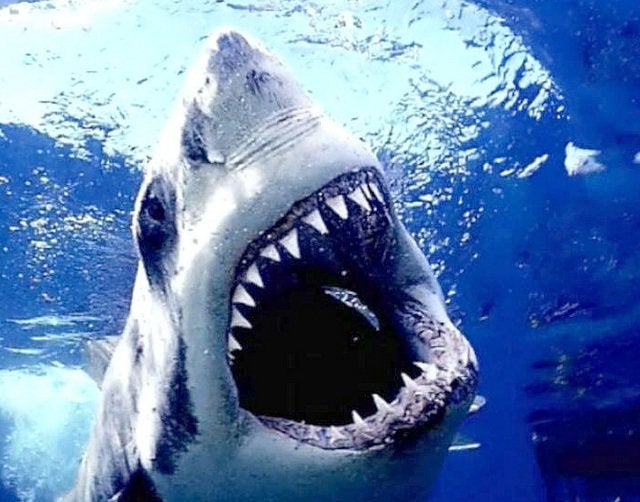
There are billions upon billions of creatures in the 7-mile deep oceans. Amongst them live the supremely graceful, beautifully designed, super-predator and most feared animal on Earth -- Carcharodon carcharias or great white shark.
Of the 368 species of shark, great whites are the most awesome and dangerous, and the largest game fish in the world.
Great white sharks are not the largest fish or the largest shark. The largest shark is a whale shark, a tropical plankton eater. Great whites, however, are considerably larger and heavier than any other predator shark.
Both shark and tree ancestors', interestingly, date back to the Devonian period some 350 million years ago.
Sharks and their relatives, the skates, rays and chimaeras, are cartilaginous fish (they contain no bones). They have multiple gills along the sides or bottom of the head.
Great white offspring develop in the uterus and are nourished by the yolk of the egg. After the eggs hatch within the oviduct they ingest nutritive fluids. The unborn embryos compete for survival -- embryos eat their siblings -- until only one is left in each of the paired oviducts.
As a result great white shark females tend to grow larger than males and give birth to a small number of large pups. There are few predators large enough to attack these babies and they have a high probability of pup survival.
Records from the Bay of Fundy in the 1930s suggest that great whites can grow as long as 36 feet and can weigh as much as 2,663 pounds.
Great whites have been compared to nuclear submarines or fighter jets and rightfully so. Their skin is covered with dermal denticles (skin teeth) likened to sandpaper roughness. The tooth-like prickles extend from the tip of the snout to the end of their tail, and offer protection against minute parasites and hungry predators (when mature there are none). Denclicles also reduce water turbulence by increasing laminar flow along the shark's surface.
The snout of great white's is conical and their eyes possess binocular vision. The underside of the snout has two separate troughs strictly for smelling, they are extremely sensitive to chemical odors. In fact, a substantial part of their brain is devoted to the sense of smell.
A series of dark holes peppering the top and underside of the snout resemble a five o'clock shadow. The tiny, jelly-filled capsules, called ampullae of Lorenzini, are sensitive to electrical discharge as minute as .005 microvolts. This enables great whites to detect a heart beat of prey buried in sand from a faint electrical field or the action of a gill or a swimming muscle of another animal.
Great whites have black eyes containing no protective membrane. When they bite the eyes roll back into the head to protect them when any contact or collision is imminent. Contrary to popular belief they have good eyesight and can discriminate color.
Sharks have ears and are able to delineate low frequency vibrations produced by wounded or struggling fish as far as 820 feet away.
Great whites contain 26 upper and 24 lower teeth as hard as granite and strong as steel. The lower teeth pin the prey whilst the upper teeth with their razor sharp serrations sever the flesh like a saw-blade.
Shark teeth are grown on a dental conveyor belt and at any one-time one third of the teeth are being replaced. During the 20-year life span, a great white may grow thousands of teeth.
Great whites and their relatives the makos, porbeagle, thresher sharks and unrelated tunas have evolved to functionally become warmer-blooded animals.
Oxygenated blood from the gills is fed to the muscles via large subsurface coetaneous arteries. The blood is warmed as a result of contact with the swimming muscles. Warm blood significantly improves performance of a predator in pursuit of prey.
One quarter of the great whites entire weight is comprised of its liver, which is five times more buoyant than water.
Great whites are surface feeders, they are pale on the underside with varying gray shades on their top half. This pattern of counter shading is used by the military for aircrafts operating low over the ocean.
The tail of the great white provides low speed torque -- once underway it moves almost effortless with a top speed of about 15 miles per hour.
Great whites are opportunistic feeders. They eat dolphins, sea lions, whales and prefer harbor, elephant, fur and lion seals.
Diminishing numbers of great whites are distributed in South Africa, South Australia, New Zealand, central California, Chile and eastern Canada. They occur in Florida and Hawaii but not often.
Great whites infrequently attack humans. Bull sharks are the most common assailants. An increase in attacks in California is due to short surfboards. Arms and legs gyrating mimic flailing seals.
There are an unknown number of great whites. They occur singly in pairs or larger numbers. Twenty-first century affluence in the Orient has created an insatiable demand for shark fin soap. So shark populations are being decimated.
And unless all shark species are protected they face extinction far sooner than most people realize. Speedo realized the importance of shark skin, as it repels water, and they have developed bathing suites that mimic shark skin texture for Olympic athletes who attempt to break records by one-one-thousandth of a second.
Great white sharks are the largest predators that the laws of physics allow on contemporary Earth -- this perfect predator is most worthy of global protection.
Dr Reese Halter is a science communicator: voice for ecology, conservation biologist at California Lutheran and public speaker. He can be contacted through www.DrReese.com.
